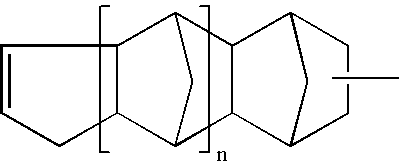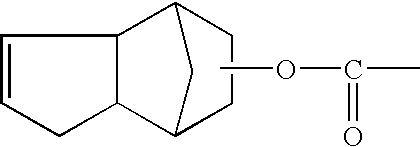Melt coating method using a polyester resin composition
- Summary
- Abstract
- Description
- Claims
- Application Information
AI Technical Summary
Benefits of technology
Problems solved by technology
Method used
Image
Examples
preparation example 1
The Preparation of the Compound 1 (Monocarboxylic Acid of formula V)
710.81 g of 93% dicyclopentadiene (5.0 mol)
490.30 g of maleic anhydride (5.0 mol)
are weighed out into a stirring flask with heating and reflux condenser. The mixture is heated to 125° C. under a gentle stream of nitrogen and then
95.00 g of water 5.0 mol+5 g (5.0 mol+5 g)
are added from a dropping funnel over the course of one hour. The mixture is left to react at 125° C. for one hour. A monocarboxylic acid of formula V is formed.
preparation example 2
The Preparation of the Unsaturated Polyester (A)
1344.00 g of dicyclohexanolpropane
1033.60 g of compound 1 from Preparation Example 1
235.20 g of maleic anhydride
278.40 g of fumaric acid
630.00 g of Polyol TP 70 (1 mol trimethylolpropane+7 mol ethylene oxide)
34.00 g of hypophosphorous acid, 50% strength (esterification catalyst)
0.50 g of hydroquinone
[0092]are weighed out into a stirring flask with heating and top-mounted distillation unit. The mixture is heated rapidly to 130° C. under a gentle stream of nitrogen. Then the temperature is raised gradually to 190° C. over the course of 41 / 2 hours, during which the water of condensation which forms is removed by distillation. Then a vacuum is applied and the temperature is held at 190° C. for three hours more. This gives a resin melt which is cast onto aluminum foil and solidifies to give a hard, blocking-resistant resin. The resin has an acid number of 14.7 and melt viscosities of 158 Pas / 120° C.; 73 Pas / 130° C.; 46 Pas / 140° C.
preparation example 3
The Preparation of a Polyester-Based Crosslinking Agent (B) Terminated with Isoprenol Ester
1753.7 g of adipic acid (6.0 mol)
478.6 g of isoprenol (5.5 mol)
368.4 g of dicyclohexanolpropane (2 mol)
261.7 g of THEIC (trishydroxyethyl isocyanurate) (1 mol)
400.0 g of toluene
6.0 g of Fascat 4201 (tin catalyst)
[0093](0.5 equivalent HO excess) are weighed out into a stirring vessel with heating and water separator. The mixture is heated rapidly to 130° C. under a gentle stream of nitrogen. Water is then separated off with vigorous boiling. After about 3 hours, the formation of water subsides. Then the temperature is raised gradually to 190° C. over the course of approximately 2 hours, during which the toluene unreacted isoprenol and some additional water are removed by distillation. Then a vacuum is applied and condensation is continued at 190° C. for 4 hours.
[0094]This gives a resin melt which is passed onto aluminum foil and solidifies to give a hard, blocking-resistant resin. The resin has...
PUM
| Property | Measurement | Unit |
|---|---|---|
| Temperature | aaaaa | aaaaa |
| Temperature | aaaaa | aaaaa |
| Temperature | aaaaa | aaaaa |
Abstract
Description
Claims
Application Information
 Login to View More
Login to View More - R&D
- Intellectual Property
- Life Sciences
- Materials
- Tech Scout
- Unparalleled Data Quality
- Higher Quality Content
- 60% Fewer Hallucinations
Browse by: Latest US Patents, China's latest patents, Technical Efficacy Thesaurus, Application Domain, Technology Topic, Popular Technical Reports.
© 2025 PatSnap. All rights reserved.Legal|Privacy policy|Modern Slavery Act Transparency Statement|Sitemap|About US| Contact US: help@patsnap.com



